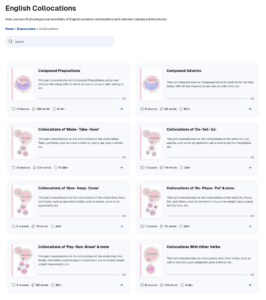The collocation section on Langeek provides a comprehensive exploration of multi-word structures within the English language. These structures, often overlooked, play a crucial role in conveying nuanced meanings. Let’s delve into the intricacies of collocations without the frills.
 Structure types
Structure types
Here is an overview of the three types of structures found in the collocation section on Langeek:
- Verb Phrases:
- A verb phrase comprises a main verb along with other words that modify or complement it. For example, consider the phrase “to take a nap.” Here, “take” is the main verb, and the entire phrase conveys the action of resting during the day.
- Compound Adverbs:
- Compound adverbs are phrases that enhance descriptions or add nuance to sentences. They often consist of multiple words. For instance, the phrase “once upon a time” evokes nostalgia and sets the stage for storytelling.
- Compound Prepositions:
- Compound prepositions express relationships between elements in a sentence. These prepositional phrases include words like “in spite of,” which convey a specific meaning related to overcoming obstacles despite unfavorable circumstances.
The Eight Categories
- Compound Prepositions
- These prepositional phrases provide context and direction. Examples include “in front of,” “on top of,” and “by means of.”
- Compound Adverbs
- Enhancing sentences, compound adverbs include phrases like “all of a sudden,” “at first glance,” and “in the meantime.”
- Verb Collocations With ‘Make- Take- Have’
- Explore actions associated with these verbs. From “make a decision” to “have a conversation,” these phrases guide communication.
- Verb Collocations With ‘Do- Set- Go’
- These phrases encapsulate activities. “Do the dishes,” “set goals,” and “go for a walk” fall into this category.
- Verb Collocations With ‘Give- Keep- Come’
- Discover giving, retaining, and arriving. Phrases like “give it a shot,” “keep your promise,” and “come to a decision” reveal connections.
- Verb Collocations With ‘Be- Place- Put’ & More
- These versatile phrases shape interactions and surroundings. “Be at ease,” “place an order,” and “put forth effort” exemplify this group.
- Verb Collocations With ‘Pay- Run- Break’ & More
- Money, movement, and change intersect here. “Pay attention,” “run errands,” and “break the ice” are part of this dynamic category.
- Collocations With Other Verbs
- This catch-all category houses unique pairings. From “catch someone’s eye” to “lose track,” it’s a linguistic playground.
What do we consider a collocation?
At LanGeek, we use the term “collocation” to describe special word partnerships. These are groups of words that native speakers naturally use together because they sound right and create a clear meaning. Imagine them as teammates working together: each word plays a specific role to deliver a complete idea.
Unlike idioms, which can be like puzzles with hidden meanings, collocations are straightforward. You can often understand their meaning just by looking at the individual words. Over time, due to frequent use in similar situations, these word pairs or even larger groups have become ingrained in our language. You’ll find them popping up everywhere – in everyday conversations with friends, in your favorite books, and even in technical documents!